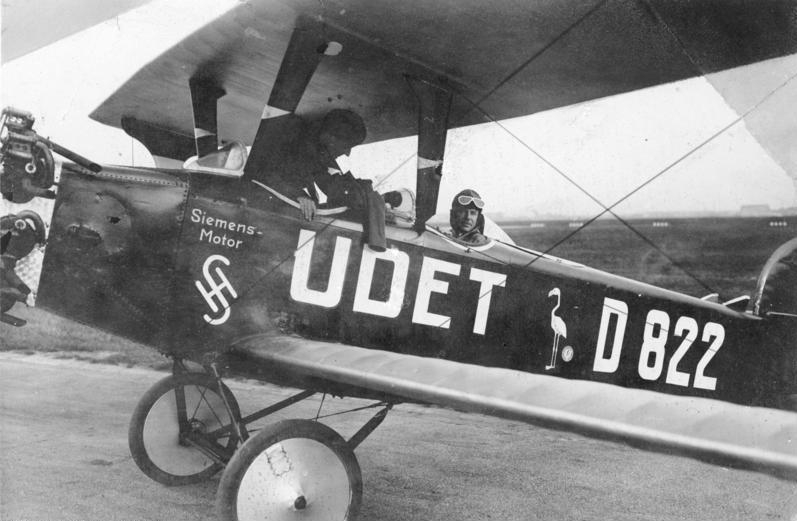Udet U 12 on:
[Wikipedia]
[Google]
[Amazon]
The Udet U 12 Flamingo was an aerobatic sports plane and trainer aircraft developed in

 No original aircraft are known to exist. An airworthy replica was kept at the
No original aircraft are known to exist. An airworthy replica was kept at the

German aircraft between 1919–1945
*
Germany
Germany,, officially the Federal Republic of Germany, is a country in Central Europe. It is the second most populous country in Europe after Russia, and the most populous member state of the European Union. Germany is situated betwe ...
in the mid-1920s.
Design and development
The U 12 was a conventional, single-bay biplane of wooden construction with the wings braced by large I-struts. The pilot and instructor or passenger sat in tandem, open cockpits. The U 12 proved extremely popular and sold well, due in no small part to Ernst Udet's spectacular aerobatics routines while flying the aircraft. One particularly acclaimed part of his act included swooping down towards the airfield and picking up a handkerchief with the tip of one wing. The popularity of this aircraft was insufficient to rescue Udet Flugzeugbau from its dire financial position, but when the company's assets were taken over by the state ofBavaria
Bavaria ( ; ), officially the Free State of Bavaria (german: Freistaat Bayern, link=no ), is a state in the south-east of Germany. With an area of , Bavaria is the largest German state by land area, comprising roughly a fifth of the total lan ...
to form BFW, production of the U 12 soon resumed in earnest. BFW-built U 12s were exported to Austria, Hungary and Latvia, and later built under licence in these countries as well.

Variants
Germany
* U 12a: main production version withSiemens-Halske Sh 11
The Siemens-Halske Sh 11 was a seven-cylinder, air-cooled, radial engine for aircraft built in Germany in the 1920s. First run in 1925, it was rated at 75 kW (100 hp). Applications
* Albatros L 68
* Bach 3-CT-2 Air Yacht
* Bach 3-CT ...
engine
** U 12W: float-equipped U 12a (''Wasser''—"water")
* U 12b: version strengthened for aerobatics and with improved wing design
* U 12c: advanced trainer with reduced wing area
* U 12d: U 12b with Siemens-Halske Sh 12
The Siemens-Halske Sh 12 was a nine-cylinder, air-cooled, radial engine for aircraft built in Germany in the 1920s. First run in 1925, it was rated at 80 kW (110 hp). The Sh 12 was also produced in the United States by Ryan Aeronautic ...
engine
* U 12e: U 12c with Siemens-Halske Sh 12
The Siemens-Halske Sh 12 was a nine-cylinder, air-cooled, radial engine for aircraft built in Germany in the 1920s. First run in 1925, it was rated at 80 kW (110 hp). The Sh 12 was also produced in the United States by Ryan Aeronautic ...
engine
Austria
20 aircraft produced by Fliegerwerft Thalerhof * U 12H: standard U 12a (''Holz''—"wood") * U 12S: U 12a with redesigned fuselage of fabric-covered steel tube construction (''Stahl''—"steel"). ** U 12Ö: alternative designation for U 12S (''Österreich''—"Austria")Hungary
Forty aircraft produced by KRG and another 40 by Manfred Weiss Works. Some examples armed and used for fighter or bomber training * Hungária I: similar to U 12a with N-typeinterplane strut
In aeronautics, bracing comprises additional structural members which stiffen the functional airframe to give it rigidity and strength under load. Bracing may be applied both internally and externally, and may take the form of strut, which act in ...
s
* Hungária II: similar to U 12a with N-type interplane struts
* Hungária III: similar to U 12a with N-type interplane struts, propeller spinner and Townend ring
* Hungária IV: similar to U 12a. Only Hungarian-built version with I-type interplane struts
* Hungária V: similar to U 12a with N-type interplane struts
Operators
; *Austrian Air Force (1927–1938)
The Austrian Air Force (''Österreichische Luftstreitkräfte'') of the interwar period began as a paramilitary organisation (1927) and was secretly built up by the government before union with Germany (1938).
History
In 1919 the peace treaty ...
;
* Royal Hungarian Air Force
The Hungarian Air Force ( hu, Magyar Légierő), is the air force branch of the Hungarian Defence Forces.
The task of the current Hungarian Air Force is primarily defensive purposes. The flying units of the air force are organised into a single ...
;
* Latvian Air Force
Latvian Air Force ( lv, Latvijas Gaisa spēki) is the aviation branch of the National Armed Forces. The first air force (AF) units were established 1992. It has no air combat capability, thus the defense of Latvian air space is maintained by NATO ...
Survivors
 No original aircraft are known to exist. An airworthy replica was kept at the
No original aircraft are known to exist. An airworthy replica was kept at the Deutsches Museum
The Deutsches Museum (''German Museum'', officially (English: ''German Museum of Masterpieces of Science and Technology'')) in Munich, Germany, is the world's largest museum of science and technology, with about 28,000 exhibited objects from ...
but crashed at the 2013 Tannkosh
Tannkosh was a large airshow and fly-in held annually in July at Tannheim, upper Swabia in Germany.
The event was the closest European equivalent to EAA AirVenture Oshkosh and, although smaller than the Oshkosh airshow, Tannkosh attracted hundr ...
event.http://aviation-safety.net/wikibase/wiki.php?id=158981 Aviation Safety Net website
Specifications (U 12a)

References
* *German aircraft between 1919–1945
*
External links
{{Udet aircraft 1920s German civil trainer aircraft U 12 Aerobatic aircraft Weiss Manfred aircraft Biplanes Single-engined tractor aircraft Aircraft first flown in 1925